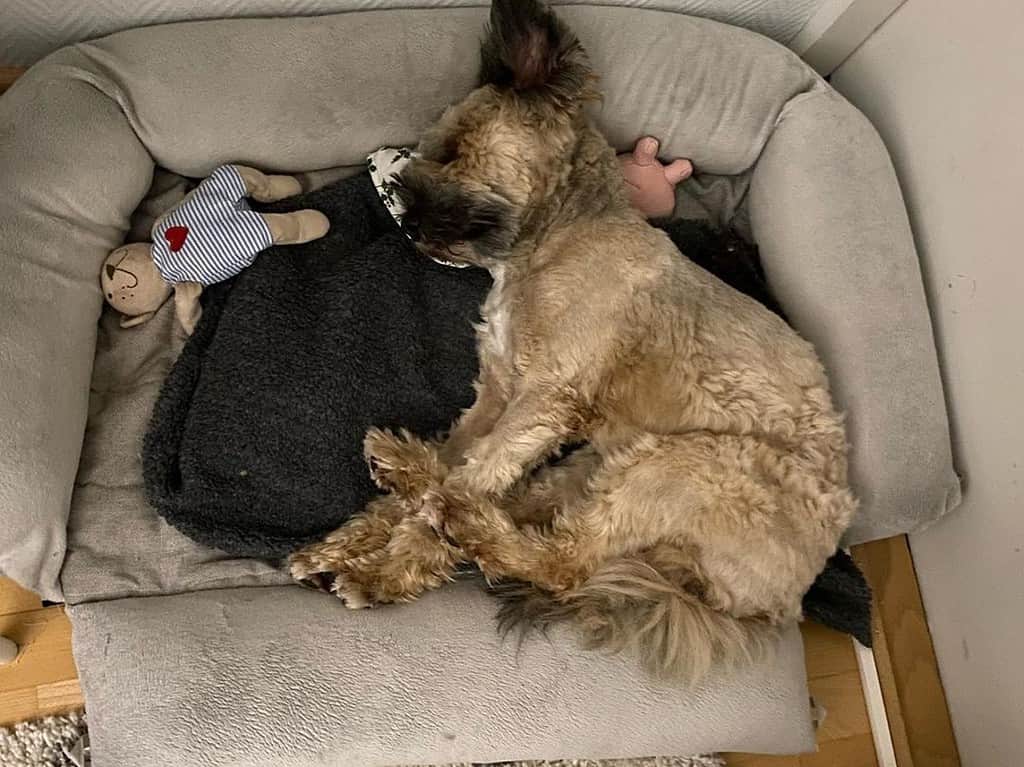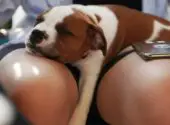Your dog is sleeping beside you. But wait, what’s that? An irregularity startles you as you notice their chest expanding and contracting rapidly, and their nose makes brief yet audible snorts. Is there something wrong with your pup?
Numerous reasons can be responsible for a dog’s faster breathing through the nose, including physical exhaustion, poisoning, anxiety, medications, and underlying health conditions. As a responsible pet parent, you must comprehend these causes and how you can provide your pet with relief so they may gain better rest.
So let’s get down to why your dog is breathing fast through their nose while catching some Z’s and how you can ensure they get the restful sleep they need.

What is Normal Breathing Rate for Dogs During Sleep?
The typical breathing rate of a healthy adult dog while at rest is estimated to be between 10 and 30 breaths per minute. The respiration rate slows and becomes more rhythmic upon entering a sleep state.
During a dog’s sleep phase, their breathing may become slower and deeper than when they are alert. This is typical and part of the natural sleep cycle. The respiratory rate during deep sleep might decline to 10 to 20 breaths per minute; however, in some cases, the rate can be lower.
Puppies have been documented to have a significantly higher baseline respiratory rate while resting or sleeping than their larger counterparts. This difference can be attributed to the need for a more accelerated breath intake as their smaller bodies require more oxygen compared to bigger dogs. Respiratory rates in younger pups generally range from 15-40 per minute when asleep, gradually declining as they mature into adults.
It bears emphasizing that dogs may exhibit distinct respiration patterns when sleeping, and it is vital to be aware of your dog’s typical breathing routine. Variables such as surrounding temperatures, activity level before sleep, and overall environment can also shape the rate of a dog’s dog’s breathing rate during sleep.
Breed Characteristics
The bodies of different dog breeds vary greatly, and these differences can cause respiratory issues as a result. Brachycephalic syndrome is commonly experienced by those with short heads and narrowed airways, such as Bulldogs, Pugs, or Boxers. This condition can cause breathing problems that become even more severe when the individual rests or sleeps.
Additionally, brachycephalic breeds breathe faster and louder, especially when relaxed or sleeping due to their narrow nasal passages. This rapid breathing through the nose assists with compensating for the restricted amount of air that can pass through their compressed airway and is usually considered ordinary for these types of breeds.
Additionally, the structure of certain breeds can lead to an increased respiration rate during slumber. With small size and faster metabolic rates, Chihuahuas or Yorkshire Terriers will likely experience more elevated breathing at rest. Similarly, Greyhounds or Whippets possess a thinner amount of fur, allowing efficient heat loss when relaxed, resulting in higher respiratory activity while sleeping.
Why Your Dog Is Breathing Fast Through Their Nose While Sleeping
It is possible that a dog’s quickened respiration during sleep can be attributed to dreaming. During the REM state of sleep, dogs and humans experience dreams that can induce physiological responses such as an acceleration in heart rate and respiration. This could explain why your pet may seem relaxed yet breathe quickly while sleeping, suggesting it is simply due to vivid dreaming.
Hyperventilation may indicate psychological distress in dogs, such as anxiety or fear. Emotional states, including nightmares, can affect the rate of respiratory rate and breath intensity alike. Such a symptom should be monitored closely if your dog has been exposed to a distressing event recently or tends to display heightened levels of anxiousness in reaction to stimuli.
However, if other concerning signs accompany fast breathing, it might indicate a health problem.
Fluid in the Lungs
Pulmonary edema, which describes an accumulation of fluid in the lungs, can result from heart disease, respiratory conditions, or side effects from medications.
Accumulated liquid within the lungs can impede normal gas exchange between oxygen and carbon dioxide, leading to an increased respiratory rate as the body works to introduce more oxygen into its circulatory system.
This explains why a dog may be seen inhaling swiftly through their nostrils while in slumber as their respiratory framework is pushing harder to provide adequate oxygen supply for their essential organs.
Heart Failure
Dogs can suffer from heart failure, which, among other symptoms, includes rapid nasal breathing while asleep. Heart failure results when the heart cannot provide sufficient blood needed by the body. Possible causes of such an ailment encompass valve dysfunction, cardiomyopathy, or infestations with heartworm.
Heart failure is an incapacitating medical disorder wherein the functioning of the heart deteriorates to a point where it is insufficiently able to pump blood. This deficiency in oxygen-rich blood can cause organs in the body to suffer from oxygen deprivation and nutrient depletion. In response to this reduced supply, certain bodily functions may increase, including heart and respiratory rates, to guarantee organs are receiving enough oxygen. These heightened changes in respiration could still occur even during sleep cycles in dogs suffering from congestive heart failure.
Onion and Garlic Poisoning
When exposed to the onion and garlic poisoning compounds containing N-propyl disulfide, dogs are vulnerable to severe damage. This toxin can cause oxidative damage to red blood cells, leading to hemolytic anemia, a condition where the red blood cells are destroyed before their natural lifespan has ended.
Exposure to onion or garlic poisoning in dogs can decrease the hematocrit, thus decreasing the amount of oxygen in their blood. Low levels of oxygen will then cause various body systems, such as the lungs, to starve for oxygen. This compromised air supply leads to labored respiration while asleep and an upward trend in the respiratory rate as a compensatory measure for minimal oxygen levels.
Additionally, onions and garlic contain compounds that can irritate and inflame the respiratory system. This may result in additional difficulty breathing, particularly during sleep when the body is relaxed, and therefore muscles managing airways are more susceptible to restriction or blockage.
Heat Stroke
Heat stroke is an incredibly hazardous and life-threatening medical condition in which a dog’s body temperature becomes too high. This commonly occurs when a dog is exposed to intense heat, and its body can no longer properly regulate its raised temperature. As dogs sleep, their bodies naturally seek to lower their temperatures through panting; however, if a pup experiences heat stroke, they will rapidly pant and breathe heavily through their mouth.
When a dog suffers from heat stroke, their body’s cooling processes become overloaded, and the intense heat harms its vital organs. The respiratory system has a major role in releasing excess heat; panting is how dogs cool themselves. Once they are affected by heat stroke, though, this greater need for temperature regulation causes a lot of additional pressure on the respiratory system. Rapid breathing through the nose while asleep may mean that even as the dog rests, it is still in distress from its condition.
Asthma
Canine asthma is an inflammatory disease characterized by airway constriction, leading to difficulty breathing. A common symptom of the disorder is rapid, laborious respiration that can appear not only while conscious but also in a sleeping state.
During sleep, the muscles throughout a dog’s body relax, including in their airways; this additional relaxation can further constrict already inflamed airways in dogs with asthma and create greater resistance to airflow. This impedes proper breathing and causes the dog to speed up their nasal breaths due to their reduced capacity to take in sufficient oxygen.
Dog asthma is triggered by exposure to pollutants, allergens, and contaminants. This results in a hypersensitive lung response – swelling and tightness of air passages.
Dogs can be susceptible to asthma due to exposure to environmental factors such as irritants, allergens, and pollutants. When triggered, an allergic reaction in the respiratory system causes inflammation and tightness of air passages. Moreover, contact with dust mites or pollen while sleeping can worsen pre-existing asthmatic symptoms, which may explain why your dog is breathing fast through their nose.
Kennel Cough
One potential explanation for a dog breathing fast through its nose is the inflammation and agitation in the respiratory passageway that often accompanies canine infectious tracheobronchitis (kennel cough). The repetitive coughing associated with kennel cough can flare up airways, making breathing more difficult. This may cause the animal to inhale faster to facilitate respiration, which might appear more notable when the pet is asleep.
In addition, mucus production due to kennel cough can result in nasal discharge. This accumulation of nasal fluid can pressure dogs’ airways, hindering their ability to breathe freely while asleep. As a response, they may engage in rapid and shallow breathing through their noses in an attempt to clear any blockage and facilitate lung ventilation.
It’s important to note that while canine infectious tracheobronchitis, also known as kennel cough, can contribute to erratic breathing, additional components may be at play. For example, if the pup has congestion in addition to tracheobronchitis, it may further affect its respiratory rate during sleep.
Effects from Medication
Certain medications prescribed for dogs may impact the respiratory system, potentially leading to changes in breathing patterns during rest. This could occur due to the medication impacting the cardiovascular system, stimulating it and causing an elevation in blood pressure, or influencing the central nervous system, which controls respiration control and regulation. Subsequently, these alterations could stem from drugs administered to dogs.
Furthermore, medication-induced dehydration can also contribute to rapid breathing in dogs. These medications have diuretic properties or cause fluid loss through alternative pathways. When dehydrated, thicker respiratory secretions and decreased airways moisture can occur, making it more difficult for a dog to breathe properly while asleep. Thus, a dog may take shallow breaths faster to compensate for the lack of humidity in their respiratory tract.
How To Monitor Your Dog’s Breathing While Sleeping
Paying close attention to your dog’s respiration while they are asleep can reveal any respiratory-related complications or distress. By staying alert and aware of their breathing patterns, you will be equipped to recognize any irregularities or issues at the earliest possible moment.
Take the time to observe and understand your dog’s natural breathing patterns while at rest. The rate and rhythm of their breathing may differ depending on the size, breed, and age, so carefully analyzing their respiration during various sleep cycles will help you gain a reliable basis for comparison.
To monitor your dog’s breathing, providing a peaceful and tranquil environment where they can relax without interruption is important. Position yourself close to your pet while observing their chest and abdominal movement during respiration. Pay attention to rapid or shallow breaths, heavy panting, or labored inhalation and exhalation that may constitute signs of distress.
It is important to monitor your dog’s breathing behaviors, in addition to simply visually observing them. As your pup sleeps, listen for the quality and pattern of their breaths; normal respiration should maintain a regular, quiet rhythm without any extra wheezing or raspy sounds. If you notice excessive snoring or anything else out of the ordinary, this could indicate underlying respiratory issues, and it is wise to seek further attention from a qualified veterinarian.
You can also purchase pet-specific monitors to monitor your dog’s respiration rate and detect inconsistencies. These devices are usually positioned under your dog’s bedding or connected to their collar, visibly providing actual information that the mobile software can track. However, it is vital to recognize that these products should only function as complementary tools and not replace direct surveillance and expert veterinary care.
How to Provide Comfort for Your Dog While Sleeping

To start, establish a tranquil sleeping environment for your dog. Provide a comfortable bed or matt suitable for their size and made of plush materials. This will support their physique while removing any pains they may have. Ensure the bedding is spotless and free from foreign substances that could impair breathing.
Dogs are particularly susceptible to rising temperatures; thus, ensuring that the room has adequate airflow and resides within a comfortable climate is necessary. Additionally, positioning your pet’s bed away from direct heat sources can help avoid distress and ease their breathing.
To address any potential sources of anxiety or stress, a peaceful and secure environment must be created for the dog. This can be accomplished by reducing loud noises around them, establishing an easy-to-follow routine, and providing gentle verbal reassurance. Utilizing calming tools such as soft music or aromatherapy can also help promote relaxation in the animal who may be breathing rapidly due to past fear or negative experiences associated with sleep.
Lastly, you should ensure your dog exercises daily to tire itself out, resulting in more restful sleep. Furthermore, activities such as interactive toys or training should be part of your canine’s routine to help minimize anxiety and promote relaxation. Achieving this can guarantee peaceful slumber without episodes of rapid breathing.
Dog Is Breathing Fast Through Their Nose: When To Seek Veterinary Care
Be aware of any changes or irregularities in your dog’s breathing rate during sleep. If panting, gasping, wheezing, or labored breathing is evident while sleeping, it may signal an underlying illness or respiratory complication. Should this occur, it is recommended that you consult a veterinarian to ascertain the cause and receive suitable treatment.




